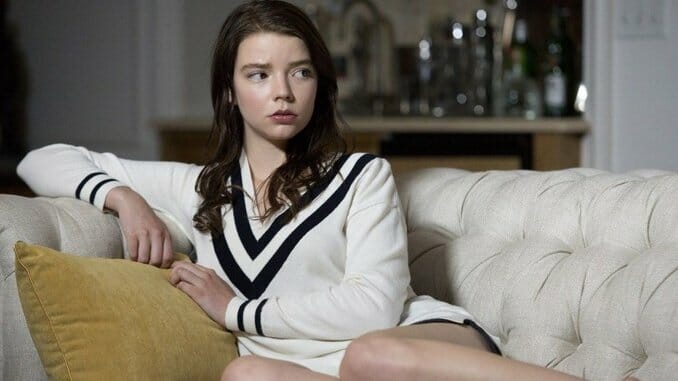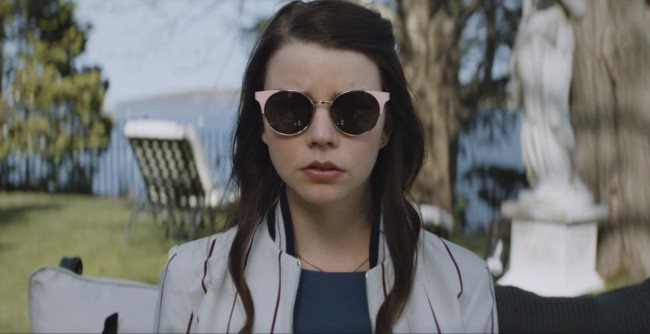Thoroughbreds Is the Underrated Gem in Anya Taylor-Joy’s Already Impressive Filmography
Photos via Focus Features Movies Features anya taylor joy
2020 was the year of Anya Taylor-Joy, there’s no doubt about that. After delighting critics and arthouse audiences in Autumn de Wilde’s casually anarchic, delightfully modern rendition of Jane Austen’s Emma, the American-born British-Argentine actress also proved the saving grace of the long-delayed, oft-cursed New Mutants, which snuck briefly into theaters this summer despite filming three years earlier. And of course, both projects were truly just setting the stage for Taylor-Joy’s main event as the star of Netflix’s The Queen’s Gambit, a historical chess limited series that unexpectedly went on to become the streamer’s most-watched miniseries ever, further cementing her rise from break-out in Robert Eggers’ The Witch in 2015 to one of Hollywood’s newly minted elite in 2020. With a docket filled with upcoming projects from superstar directors, Taylor-Joy’s striking features will likely be a mainstay on our screens for years to come.
How odd, then, that one of the most mesmerizing performances (and best films) of the young actress’ career has largely been swept under the rug, despite the fact that it was released as recently as 2018. Cory Finley’s Thoroughbreds is a stunning psychological thriller, tinged with both black comedy and horror, and features outstanding performances from both Taylor-Joy and co-star Olivia Cooke, worthy of making both young women major breakout stars in American cinema. Critically praised but seemingly misconstrued all the same at its time of release, Thoroughbreds dropped off the radar into indie movie purgatory following a brief release in the spring of 2018, but now it’s time for all the newly minted Anya Taylor-Joy fans to discover what is easily her most underrated and underseen performance. If you enjoyed the mind games of The Queen’s Gambit, just wait till you see the strings being pulled in Thoroughbreds.
In this film, Taylor-Joy plays Lily, a wealthy high school overachiever who resides in a palatial estate of truly ostentatious decadence—the kind of place where seemingly every wall is made of marble, and every archway between rooms is bedecked with faux columns. Despite this finery, we immediately get the sense that she’s miserable—trapped in a cold, loveless house with a meek mother (Francie Swift) and overbearing, immediately disconcerting stepfather (Paul Sparks), she exudes existential upper crust ennui. Before we’ve even seen vaguely menacing stepfather Mark in person, we can surmise what a piece of work he must be from the photos on his desk alone—one shows him smirking over the corpse of a lion shot on safari, while the next is a vanity shot of the guy posing with a katana in a dojo. He seems to resent everyone and everything in his orbit; a bundle of repressed rage that evokes Jack Torrance in the interview scene of The Shining—something the soundtrack of Thoroughbreds also suggests, with its off-kilter ambient vibe. The mere fact that Lily has reconnected with an old childhood friend, Amanda (Cooke), seems to make Mark deeply angry for reasons he can’t even fathom.
If only he knew what the two were really discussing, though. Ostensibly reviving their early childhood friendship in order to study together, the relationship between Lily and Amanda quickly takes on a more sinister air. Amanda is an outcast from their well-to-do society, you see—she’s awaiting a court date on an animal cruelty case after being forced to violently euthanize her childhood horse when it became badly injured. One gets the sense that this cloud of scandal around her is half the reason Lily agrees to tutor Amanda in the first place, because she’s curious what it will feel like to be around someone who has committed such an act. We perceive her as someone who is curious to dip a toe into deeper, darker waters.
And when it comes to Amanda, still waters run deep. Truly, Olivia Cooke’s work in Thoroughbreds is masterful, taking on Amanda as a largely placid, self-diagnosed (but cautious) sociopath who comes to believe that her condition “doesn’t make me a bad person—it just means I have to try harder to be good.” Of course, “good” is totally relative. Faking tears as a child in order to comfort your friend after the loss of her father? That qualifies as “good” to the moral compass of Amanda. And now that they’re older, why shouldn’t permanently removing a cruel stepfather qualify as the same sort of favor one assists a friend in achieving? If you feel neither joy nor guilt, how hard is it really to perform a “cost benefit analysis” and conclude that the world would be better off without Mark in it? Cooke conveys this semi-robotic style of reasoning with a subtlety of expression that hints at the remaining vestiges of humanity inside her, while also demonstrating Amanda’s skilled use of mimicry to fool the world into believing she’s just like everyone else. Suffice to say, she is not—if she was, she probably wouldn’t be suggesting the pair conspire to murder Mark. Together, the two unlock the power of disarming, incisive honesty when they’re able to start speaking to each other with an openness that is impossible for most of us.

Given that set-up, Heathers almost always seems to be the default point of comparison for this movie—the 1989 teen classic is name-checked in nearly every pull quote used to promote Thoroughbreds—but the two films ultimately exist in significantly different universes on closer inspection. Heathers styles itself as a snarky black comedy that is a send-up of the bitchy, mean-girl politics of high school society, where social standing and popularity is everything. Although Thoroughbreds may take place in a superficially similar social caste, it revolves around characters who seem utterly unconcerned about such things—in fact, there’s only one very brief scene where we see either of the girls around any of their other peers. And where Heathers is an outrageous satire that is trying very hard to elicit genuine laughter from its audience via macabre humor and offensive dialog, Thoroughbreds may have a few scenes that make one laugh, but that laughter is more of a defense mechanism against its frankness in exploring dark themes in a realistic way. This ultimately makes Thoroughbreds a much more serious and genuine exploration of what it might take (and what it might cost) for a teenage girl to make peace with cold-blooded murder.
Neither is Cooke’s Amanda a true parallel for the psychopath ultimately played by Christian Slater in Heathers—she gets no kicks from euthanizing her horse or conspiring with Lily to commit murder. Nor does she try to convince Lily of this course of action, beyond giving voice to the sentiment that was already in the air. We’re meant to distrust Amanda because she describes herself as lacking emotion, but that doesn’t mean she’s instead filled with indiscriminate evil. Rather, the emotional hole in her simply removes inhibitions and leaves her a startlingly honest person, and ultimately a rather virtuous one. Instead, we come to realize it’s Lily who we should have been keeping a closer eye on all along.

And it’s in this flip-flop of the audience’s perception of these two girls that Anya Taylor-Joy manages to reassert herself, recapturing the dramatic impetus that for much of the film belongs to the scene-stealing Cooke. We realize that we’ve been meant to see Lily as a sort of ditzy audience proxy all along—a passive pair of eyes through which we can gawk at the eccentricities of Amanda. Only as the story progresses do we begin to become aware of the darkness within Lily as well. And it’s not darkness that has been implanted by Amanda, or even “awoken” by her, as Lily would likely tell herself by way of rationalization. The ugliness has always been within her. Moreover, Lily comes to realize that she can harness that very perception that we the audience (and by extension, the people in the world around her) have of her as this fragile, self-obsessed teenage girl without the capacity for shocking conduct. The way the world sees her is eventually realized as an asset, rather than a liability, because it shields her from any suspicion that she could ever be as cold and calculating as she eventually becomes.
Millions of American viewers have now seen that sort of steely determination in the eyes of Anya Taylor-Joy as she stares down at an opponent over a chessboard, probing for weaknesses in The Queen’s Gambit. It’s high time that those same viewers develop an appreciation for another of her finest performances—not to mention an incredible one from Olivia Cooke, and some great scenes from the late Anton Yelchin, while we’re at it—in Thoroughbreds. Decades from now, if we’re canonizing Anya Taylor-Joy as one of the greats, it’s a film we’ll be pointing to as indicative of everything that played a part in her rise to greatness.
Jim Vorel is a Paste staff writer and resident bizarre film geek. You can follow him on Twitter for more film writing.